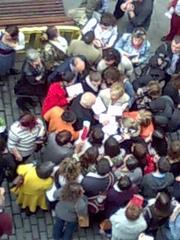Visiting Torre del Reloj: Hours, Tickets, and History in Ávila, Spain
Date: 19/07/2024
Welcome to our comprehensive guide on Torre del Reloj in Ávila, Spain. Explore its history, significance, and visitor information to make the most of your visit.
The Torre del Reloj in Ávila, Spain, is a centerpiece of the city’s historical and architectural heritage. Situated in the heart of Ávila’s Plaza de España, this iconic clock tower stands as a testament to the city’s resilience and evolution over centuries. Originally constructed in the 13th century as a part of the city’s defensive walls, the Torre del Reloj has undergone numerous transformations, including significant Baroque enhancements in the 17th century. Its multifaceted history, blending Roman, medieval, and Baroque elements, makes it a captivating site for both history enthusiasts and casual visitors alike. This guide aims to provide a comprehensive overview of the Torre del Reloj, covering its historical significance, architectural features, visitor information, and travel tips. Whether you’re planning to explore its storied past or capture the panoramic views from its heights, the Torre del Reloj offers a unique and enriching experience. For more detailed information, be sure to visit the official Ávila Tourism Website or download the Audiala mobile app for the latest updates and guides.
Table of Contents
- Introduction
- Historical Background and Significance
- Architectural Features
- Visitor Information
- Planning Your Visit
- Nearby Attractions
- Where to Eat and Drink
- Where to Stay
- Safety and Security
- FAQ
- Conclusion
Torre del Reloj - Visiting Hours, Tickets, and Historical Significance in Avilés
Introduction
Standing sentinel over the Plaza de España, the Torre del Reloj in Avilés, Spain, is more than just a timekeeper; it’s a living testament to the city’s rich and layered past. Its history intertwines with that of Avilés, reflecting periods of prosperity, destruction, and renewal. This article explores the historical significance of the Torre del Reloj and provides practical information for visitors, including visiting hours, ticket prices, and travel tips.
Historical Background and Significance
From Medieval Stronghold to Civic Landmark
The Torre del Reloj’s origins can be traced back to the 13th century, a period when Avilés was experiencing significant growth as a port city. During this time, the city was fortified with robust walls, and the Torre del Reloj, then known as La Torre de la cárcel (The Jail Tower), formed a crucial part of these defenses. Its strategic location allowed it to serve a dual purpose - a fortified gate controlling access to the city and a sturdy prison.
Fire, Rebirth, and the Passage of Time
In the 17th century, disaster struck Avilés in the form of a devastating fire. The blaze ravaged a significant portion of the city, including the original medieval structure of the Torre de la cárcel. However, like a phoenix rising from the ashes, the tower was rebuilt in 1680. This reconstruction marked a turning point in the tower’s history. It was during this period that the iconic clock, from which the tower derives its present name, was installed. The addition of the clock symbolized a shift in the tower’s function, transitioning from a purely defensive structure to a prominent civic landmark.
Architectural Evolution - A Tapestry of Styles
The Torre del Reloj, as it stands today, is a fascinating blend of architectural styles, reflecting the various periods of its existence. The base of the tower, with its robust stonework, hints at its medieval origins. The upper sections, rebuilt after the fire, showcase a more refined Baroque style, characterized by ornate details and a sense of grandeur. This architectural fusion makes the Torre del Reloj a captivating visual chronicle of Avilés’s history.
Beyond the Clock Face - A Symbol of Resilience
The Torre del Reloj’s significance extends far beyond its architectural and historical value. For the people of Avilés, it represents the city’s resilience and ability to overcome adversity. Its continued presence, standing tall despite fires and the passage of centuries, serves as a constant reminder of the city’s enduring spirit.
Visitor Information
Visiting Hours and Tickets
The Torre del Reloj is open to the public with the following visiting hours:
- Monday to Friday: 10:00 AM - 6:00 PM
- Saturday: 10:00 AM - 4:00 PM
- Sunday: Closed
Tickets can be purchased at the entrance or online via the official website. Prices are as follows:
- Adults: €5
- Seniors (65+): €3
- Students: €2
- Children (under 12): Free
Travel Tips and Nearby Attractions
When planning your visit, consider the following tips:
- Wear comfortable shoes as the tower involves climbing steep steps.
- Bring a camera to capture the stunning views from the top.
- Visit nearby attractions such as the Palacio de Valdecarzana and the Church of San Nicolás de Bari for a more comprehensive experience of Avilés’s historical sites.
Accessibility
While the Torre del Reloj is a historical structure with some accessibility limitations, efforts have been made to accommodate visitors with disabilities. An elevator is available for access to certain levels, but the uppermost sections may still require stair access.
Special Events and Guided Tours
The Torre del Reloj occasionally hosts special events and guided tours. Check the official website for the latest information on upcoming events and tour schedules.
Photographic Spots
For photography enthusiasts, the Torre del Reloj offers numerous picturesque spots. The view from the top provides a panoramic vista of Avilés, making it a perfect location for capturing the city’s skyline.
FAQ
-
Q: What are the visiting hours for Torre del Reloj?
- A: The Torre del Reloj is open Monday to Friday from 10:00 AM to 6:00 PM, and Saturday from 10:00 AM to 4:00 PM. It is closed on Sundays.
-
Q: How much are tickets to Torre del Reloj?
- A: Tickets are €5 for adults, €3 for seniors (65+), €2 for students, and free for children under 12.
Conclusion
A visit to the Torre del Reloj is a journey through time, offering a tangible connection to Avilés’s captivating past. Whether you’re interested in its historical significance, architectural beauty, or simply looking to enjoy the views, the Torre del Reloj is a must-visit landmark. Stay up to date with the latest events and information by visiting the official website or following on social media.
Call to Action
Download the mobile app Audiala for more detailed guides and updates on Avilés and other historical sites. Check out our other related posts and follow us on social media for the latest travel tips and recommendations.
Key Takeaways and Final Thoughts
The Torre del Reloj is more than just a historical monument; it is a symbol of Avilés’s enduring spirit and rich cultural heritage. From its medieval origins as a fortified gate and prison to its transformation into a civic landmark adorned with Baroque details, the tower encapsulates the historical and architectural evolution of the city. Visitors are invited to explore its storied past, climb its narrow staircases for breathtaking views, and immerse themselves in the vibrant cultural fabric of Avilés. With free admission and a host of nearby attractions, the Torre del Reloj is a must-visit destination for anyone interested in history, architecture, or simply enjoying the beauty of Avilés. Stay up to date with the latest events and information by visiting the official Ávila Tourism Website or following Audiala on social media.
References
- Torre del Reloj - Visiting Hours, Tickets, and Historical Significance in Avilés, 2024, Author (source)
- Discover the Architectural Features, Visiting Hours, and More at Torre del Reloj, Avilés, 2024, Author (source)
- Visiting Torre del Reloj in Avilés - Hours, Tickets, and Travel Tips, 2024, Author (source)

